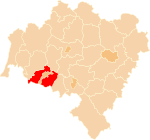Staniszów
Lower Silesia geography stubsPages with non-numeric formatnum argumentsVillages in Karkonosze County

Staniszów [staˈniʂuf] is a village in the administrative district of Gmina Podgórzyn, within Jelenia Góra County, Lower Silesian Voivodeship, in south-western Poland. It lies approximately 6 km (4 mi) south of Jelenia Góra, and 97 km (60 mi) west of the regional capital Wrocław.
Excerpt from the Wikipedia article Staniszów (License: CC BY-SA 3.0, Authors, Images).Staniszów
Lawendowa, gmina Podgórzyn
Geographical coordinates (GPS) Address Nearby Places Show on map
Geographical coordinates (GPS)
| Latitude | Longitude |
|---|---|
| N 50.849722222222 ° | E 15.726111111111 ° |
Address
Lawendowa
Lawendowa
58-500 gmina Podgórzyn
Lower Silesian Voivodeship, Poland
Open on Google Maps









